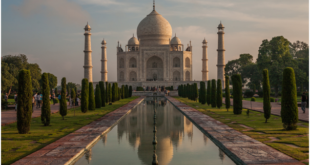Mere name of Agra creates a visual of Taj Mahal in the mind of everyone, who knows nothing, something or everything of Taj Mahal– one of the Seven Wonders of the World. The city which had been the Mogul capital at a time of the era is hardly 200 kilometers away from the capital of India, New Delhi and very well connected with fast roads and railway network.
- Best Places to Visit in Mathura – Vrindavan & Barsana
- Gatimaan Express : Fastest Indian train @160 km/hr from New Delhi to Agra
Agra is one of the prominent destinations of the World Tourism map with three heritage monuments – The Taj Mahal, Fatehpur Sikri & Red Fort.
Top 10 Places to Visit in Agra
Besides, there are numerous other monuments which have their genesis along with Taj Mahal of Agra, but are paid little attention. Let us tell you about the 10 Best Places to Visit in Agra.
1. Taj Mahal : A Love Story Immortalized in Marble and Stone!
The Taj Mahal is the finest example of Mughal architecture–a style that is a subtle blend of elements from Persian, Indian and Turkish architecture. The Taj Mahal has achieved special note because of the romance of its inspiration. Some people perceive that only the white domed marble mausoleum is Taj. The Taj Mahal is actually an integrated complex of structures that contains gardens, gateways, inns and a mosque.

Taj Mahal was constructed between 1631 A.D and 1654 A.D. The construction is said to have been done by a workforce of 22,000 that contained among others laborers, Naqqashi laborers, painters, stonecutters, garden-layers, gardeners, embroidery artists and masons. The Mughal Emperor Shah Jahan commissioned its construction as a mausoleum for Mumtaz Mahal. It is said that Shah Jahan was very much pained by the death of his favorite wife. He constructed this mausoleum so that its pleasant site would give him solace.
Some little known facts about Taj Mahal :
- Shah Jahan had planned construction of another Taj Mahal in black marble on the other side of the river, but the war with his sons interrupted his plans.
- Some people think that Geronimo Veroneo, an Italian, designed the Taj Mahal.
- Supposedly, there are two staircases on the northern side of the red sandstone plinth that lead into a basement containing 17 chambers, with a third crypt in the center.
- Some important studies feel that the Taj Mahal is sinking.
- The name Taj Mahal when translated means “Crown Palace” or “Crown of the Palace.”
- Some think that the changing colors of the tomb depict the different moods of a woman.
The Taj stands on a raised, square platform (186 x 186 feet) with its four corners truncated, forming an unequal octagon. The architectural design uses the interlocking arabesque concept, in which each element stands on its own and perfectly integrates with the main structure. It uses the principles of self-replicating geometry and symmetry of architectural elements.
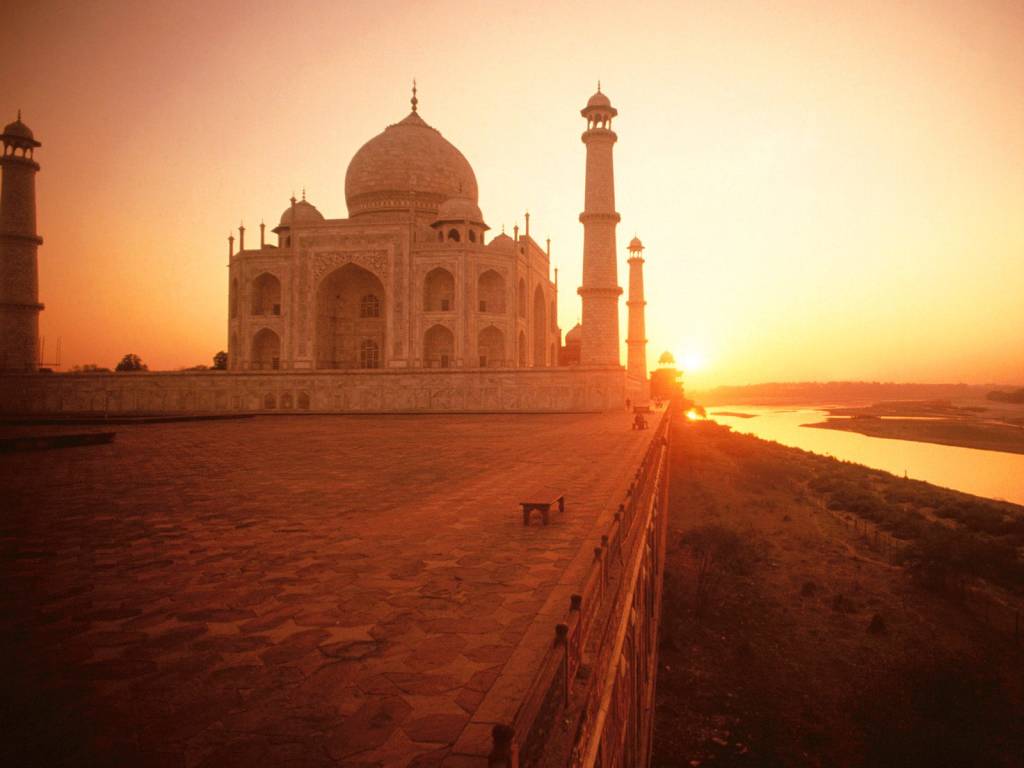
The mausoleum is a part of a vast complex comprising of a main gateway, an elaborate garden, a mosque (to the left), a guest house (to the right), and several other palatial buildings. The Taj is at the farthest end of this complex, with the river Jamuna behind it. The large garden contains four reflecting pools dividing it at the center. Each of these four sections is further subdivided into four sections and then each into yet another four sections. Like the Taj, the garden elements serve like Arabesque, standing on their own and also constituting the whole.
The main entrance, once guarded with solid silver gates, is a maze of marble embroidery; inlaid in the wall in jeweled script are quotations from the Koran, one of which invites the “pure in heart” to enter “the gardens of Paradise.”
After reaching the city you can easily get taxi, tempo, auto-rickshaw and cycle rickshaw that will take you to your destination. Prepaid taxis are also available if you want to visit the various places near the city. For the adventurous kind, there are bicycles that can be hired on hourly basis from different parts of the city. Since, diesel and petrol vehicle are not permitted in the Taj Mahal area, you can find battery-operated buses, horse-driven tongas, rickshaws and other pollution-free vehicles there.
2. The Agra Fort
The Agra Fort, also known as the “Lal –Qila”, is the highlight of the city of Agra, then capital of the Mughal Sultanate . A symbol of power, strength and resilience, as it stands today in full glory. On visiting the Agra Fort, you will come across Diwan-i-Am or the Hall of Public Audience.
This hall with numerous pillars is said to be erected by Shah Jahan in the year 1628. On heading little forward, you will see Royal Pavilions abounding in elegant mosques including Nagina Masjid and Mina Masjid, palaces like Macchi Bhavan, Khas Mahal, Shish Mahal and Shah Jahani Mahal and the Zenana Mina Bazaar.
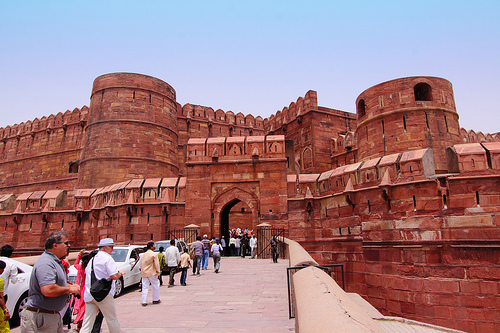
On a visit to Agra Fort, you will be attracted to the intricate carvings and the pure marbles that are used in its making. Besides, the breathtaking views of the Yamuna River and Taj Mahal from the balconies of the pavilions will leave you mesmerized.
3. I’timād-Ud-Daulah Tomb
The Empress Nur Jahan built the I’tmada-ud-daulah Tomb, sometimes called the “Baby Tāj”, for her father, Mirza Ghiyas Beg, the Chief Minister of the Emperor Jahangir. Located on the left bank of Yamuna river, the mausoleum is set in a large cruciform garden, criss-crossed by water courses and walkways.
The area of the mausoleum itself is about 250 sq ft, and is built on a base that is about 540 sq ft and about one meter high. On each corner are hexagonal towers, about thirteen meters tall. Small in comparison to many other Moghul-era tombs, it is sometimes described as a jewel box. Its garden layout and use of white marble inlay designs surpass many elements of the Taj.
4. Sikandra
The last resting place of King Akbar the Great, known as Sikandra is situated in the outskirt of the city towards Delhi road. It reflects the completeness of his personality.
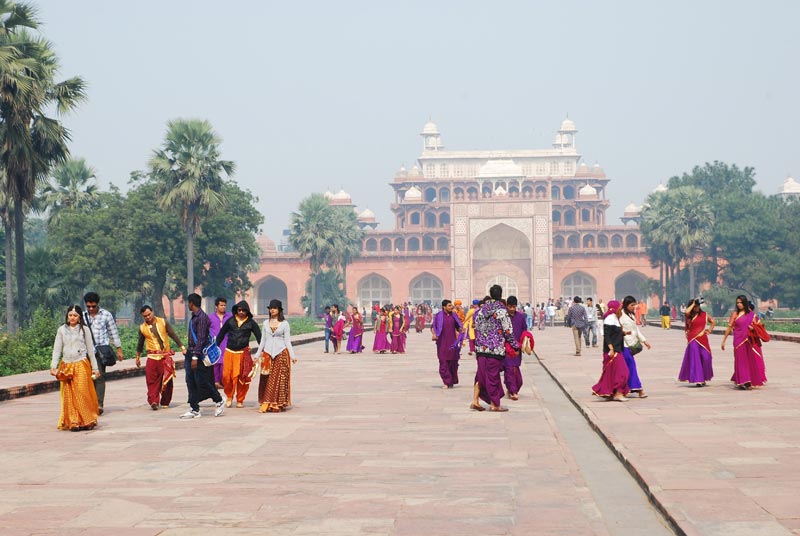
The vast, beautifully carved, red-ochre sandstone tomb with deers, rabbits and langurs is set amidst a lush garden. It is believed that Akbar himself planned his own tomb and selected a suitable site for it.
5. Jama Masjid
It is a large mosque attributed to Shah Jahan’s daughter, Princess Jahanara Begum, built in 1648, notable for its unusual dome and absence of minarets. The inscription at its entrance shows that it cost Rs 5 Lakhs at the time of its completion.
6. Chīnī kā Rauza
Notable for its Persian influenced dome of blue glazed tiles, the Chini Ka Roza is dedicated to the Prime Minister of Shāh Jahān, ‘Allāma Afzal Khāl Mullā Shukrullāh of Shiraz.
7. Rām Bāgh
The oldest Moghul Garden in India, the Ram Bagh was built by the Emperor Babar in 1528 on the bank of the Yamuna. It lies about 2.34 km north of the Tāj Mahal. The pavilions in this garden are designed so that the wind from the Yamuna, combined with the greenery, keeps them cool even during the peak of summer.
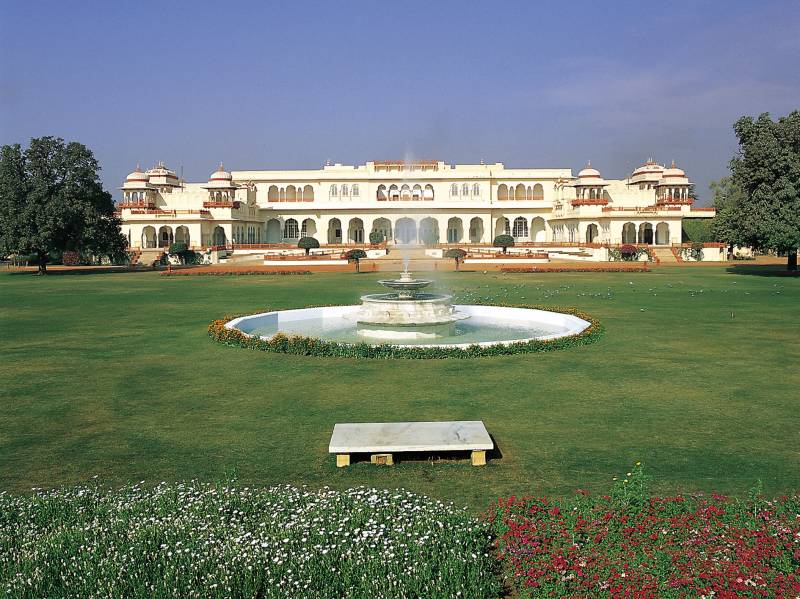
The original name of the gardens was Ārām Bāgh, or ‘Garden of Relaxation’, and this was where the Mughal emperor Bābar used to spend his leisure time and where he eventually died. His body was kept here for some time before sending it to Kabul.
8. Mariam’s Tomb
The Tomb of Mariam, the wife of great Mughal Emperor Akbar is situated within the compound of the Christian Missionary Society.
9. Mehtāb Bāgh
The Mehtab Bagh, or ‘Moonlight Garden’, is on the opposite bank of the River Yamuna from the Tāj Mahal.
10. Fatehpur Sikri
A city predominantly in red sand-stone, situated at a distance of 37 kms from Agra, was built by the Mughal Emperor Jalal-ud-din Mohammad Akbar, in honour of the great Sufi saint Salim Chisti ; its magnificence and uniqueness offers a fine example of the emperor’s architectural finesse. Akbar’s tolerant religious views and interest in literature, architecture and fine arts gave the buildings at Fatehpur Sikri a charismatic blend of Islamic and Hindu elements in their style and design.
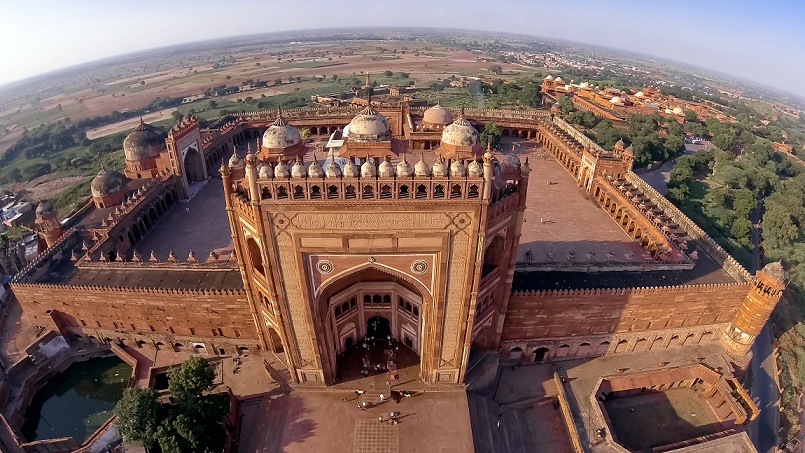
At Fatehpur Sikri during sunset and sunrise, the turrets and domes create shadows and silhouette against the copper red sky; which truly is an inspirational scene for a painter’s canvas or the visitor’s eyes.
Fatehpur Sikri is enclosed by a 11 kms long fortification wall interspersed with numerous gateways. The remains of the great city; the Imperial Palace Complex, the intricately built marble tomb of the great Sufi saint, Salim Chisti and the grand mosque are second only to The Taj Mahal, a benchmark of architectural beauty.A rich imagination is all it takes to transport any visitor to the era of gold tapestry, drapes, rich plush carpets and the royalty of the Mughal courts.
Adjoining Taj Mahal, the Taj Nature Walk, Keetham lake, Guru Ka Taal Gurudwara are also some major attractions of Agra.
You may also like to Read :
 Amazing India Blog Know India Better
Amazing India Blog Know India Better




